General
In 1874 the Strand Union Infirmary in Cleveland Street became the Infirmary for the newly created Central London Sick Asylum District, which had been established by the Metropolitan Asylums Board in 1868. It was the second infirmary belonging to the District, the first being the St Pancras Union Infirmary in Highgate. It had 211 beds and became known simply as the Cleveland Street Infirmary. By the following year it had 264 beds. (By 1890 it was becoming overcrowded and a new infirmary for the District was built at Colindale in 1900.)
The 4-storey building had originally been built between 1775 and 1778 as the workhouse for the parish of St Paul's, Covent Garden, on the site of its burial ground. The projecting end blocks on either side of the building had been added in 1829, giving it its 'H' shape. The workhouse then housed about 550 people in 330 beds. The appalling overcrowded conditions inside it had been reported in The Lancet in 1865, and the resulting debate had contributed to the passing of the Metropolitan Poor Act, 1967, and the creation of the Metropolitan Asylums Board (MAB).
The Infirmary, which had been used by MAB as a children's hospital, closed in September 1915, and the staff transferred to the Highgate Infirmary.
In 1924 the building was purchased by the Middlesex Hospital. It was in a bad state of repair, but was renovated and adapted for use as an annexe to the main hospital on the opposite side of Cleveland Street.
The Annexe was officially opened in February 1926 by the Minister of Health, Neville Chamberlain. It had six wards with 31 beds in each, and two up-to-date operating theatres and their adjacent rooms. The light over the operating table was cleverly arranged so as to throw no shadow wherever the surgeon might be working.
In-patients were transferred to the Annexe while the old West Wing of the Middlesex Hospital was demolished and rebuilt. The new Hospital finally opened in 1935, and the Annexe then became its Out-Patients Department.
Present status (September 2010)
The western end of the original workhouse is the only part to survive. It is the oldest example of a Georgian workhouse in London but, despite its history and architecture, it is not a listed building and is now under threat of demolition.
A planning application was submitted recently to the London Borough of Camden by its owners, the University College Hospital NHS Trust. The Trust proposes to demolish the buildings and to build 5-, 6- and 10-storey blocks containing some 140 apartments and retail premises, with a walkway to Charlotte Street.
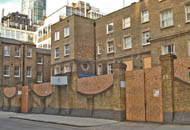
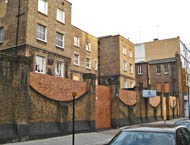
Photographed in November 2007, the buildings lie in the Borough of Camden and not Westminster, so were not included in the sale of the main Middlesex Hospital site.
The buildings, built of plain stock brick, are set back from the road behind a wall with tall pillars and two gateways. The central recessed portion is five windows in width, and the projecting wings have two sash windows to a floor. At each end of the wall is a 2-storey side building fronting Cleveland Street.
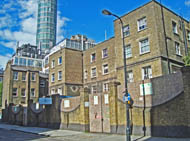

The buildings are still awaiting their fate in September 2010.

The buildings are currently occupied by Camelot, a property protection organisation.
Update March 2012
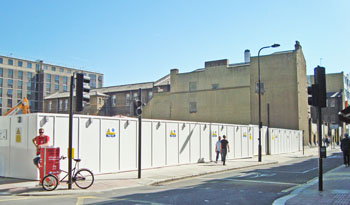
Since the Medical School buildings on the corner of Cleveland Street and New Cavendish Street were demolished in 2011 the northern side of the former Out-Patients Department can now be seen (above and below).
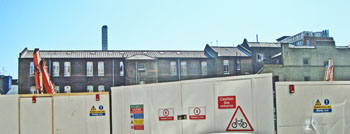
(Author unstated) 1900 The New Infirmary of the Central London Sick Asylum District. British Medical Journal 1 (2049), 884-885.
(Author unstated) 1915 (Untitled). British Journal of Nursing, 25th September, 257.
Black N 2007 London's last remaining Georgian workhouse infirmary under threat. British Medical Journal 335 (7633), 1312.
Hopkins J 1881 Metropolitan Sick Asylum: Cleveland Street Infirmary. The Lancet 118 (3041), 998-999.
http://news.fitzrovia.org.uk (May 2010)
http://news.fitzrovia.org.uk (July 2010)
www.aim25.ac.uk
www.british-history.ac.uk
www.derelictlondon.com
www.nhshistory.net
www.workhouses.org.uk
Return to home page